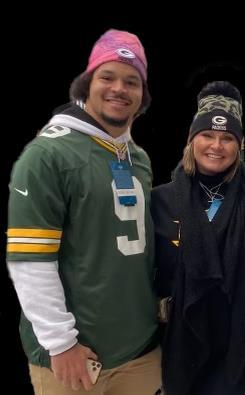




























15 and The Mahomies
Why Are Friends So Important
How To Prevent Burnout of Young Athletes



Five Investment Rules To Consider For Long-Term Investing































15 and The Mahomies
Why Are Friends So Important
How To Prevent Burnout of Young Athletes



Five Investment Rules To Consider For Long-Term Investing

Patrick Mahomes' accolades on the field are well known. The 27-year-old Kansas City Chiefs quarterback has two Super Bowl rings (LIV and LVII), two Super Bowl MVP trophies, and two regular season NFL MVP trophies (2018 and 2022). Mahomes is also a five-time Pro Bowler, has led the NFL in passing touchdowns twice, and he is on pace - even ahead of Tom Brady - to setting career accomplishments in the shortest amount of career time.
Oh, it is also worth pointing out that Mahomes isn't even in his prime yet based on the age of previous Hall of Fame quarterbacks and when they peaked.
Another place where Mahomes is becoming an all-time great is in his charity work. Countless NFL players have their own charities, and most do outstanding work in their communities.
Mahomes is one such player, with his 15 and The Mahomies charity going from strength to strength to help those in need in Kansas City and beyond.

It is easy to assume that an NFL player - especially a star of Mahomes' magnitude - would be far too busy during the season to think of anything other than football (and recovery.) This is clearly not the case with Mahomes hosting his Third Annual 15 and the Mahomies Foundation Gala in December 2022. That gala saw over 25 charities given grants that totaled over $400,000, with Mahomes and his team as the face of the fundraising efforts.
It seems important to Mahomes that his foundation covers the work of many charities

instead of funneling all the money collected into one pot. It is also essential to the quarterback that the charities have a specific focus, with his fundraising prioritizing charities that support health, wellness, and resourceneedy communities where the money will have the most significant impact.

The lesson from this is that you are never too busy to make a difference in the lives of those who need it most. For every State Farm commercial you see Mahomes on - and there are plenty of them - the quarterback is working in the shadows to up his fundraising potential.
Sure, Mahomes has the star power to help secure major donors, but that is nothing without the want he has to make a difference. It isn't about ego with Mahomes or being seen to do the right (expected) thing. He is a man who genuinely cares and understands that he is in a position to give back thanks to the gifts he has been blessed with on the football field.

The Walter Payton Man of the Year award is the NFL's way of supporting the charitable work of its players. Mahomes has yet to win the Payton MOTY - the 2022 trophy he was in the running for went to Dak Prescott of the Dallas Cowboysbut you can bet that this is an award Mahomes will feel he needs to complete his NFL collection.
With his combination of drive, passion, and desire to succeed, few would doubt that a Walter Payton trophy will one day be sitting in the trophy cabinet alongside Mahomes' evergrowing collection of NFL hardware.
Article by Steve Wright









Our society tends to place an emphasis on romantic relationships. We think that just finding that right person will make us happy and fulfilled. But research shows that friends are actually even more important to our psychological welfare. Friends bring more happiness into our lives than virtually anything else.
Friendships have a huge impact on your mental health and happiness. Good friends relieve stress, provide comfort and joy, and prevent loneliness and isolation. Developing close friendships can also have a powerful impact on your physical health. Lack of social connection may pose as much of a risk as smoking, drinking too much, or leading a sedentary lifestyle. Friends are even tied to longevity. One Swedish study found that, along with physical activity, maintaining a rich network of friends can add significant years to your life.
But close friendships don’t just happen. Many of us struggle to meet people and develop quality connections. Whatever your age or circumstances, though, it’s never too late to

make new friends, reconnect with old ones, and greatly improve your social life, emotional health, and overall well-being.

While developing and maintaining friendships takes time and effort, healthy friendships can:
- Improve your mood. Spending time with happy and positive friends can elevate your mood
and boost your outlook.
- Help you to reach your goals. Whether you’re trying to get fit, give up smoking, or otherwise.

- improve your life, encouragement from a friend can really boost your willpower and increase your chances of success.
- Reduce your stress and depression. Having an active social life can bolster your immune system and help reduce
isolation, a major contributing factor to depression.

- Reduce your stress and depression. Having an active social life can bolster your immune system and help reduce isolation, a major contributing factor to depression.
- Support you through tough times. Even if it's just having someone to share your problems with, friends can help you cope with serious illness, the loss of a job or loved one, the breakup of a relationship, or any other challenges in life.
- Support you as you age. As you age, retirement, illness, and the death of loved ones can often leave you isolated. Knowing there are people you can turn to for company and support can provide purpose as you age and serve as a buffer against depression, disability, hardship and loss.
- Boost your self-worth. Friendship is a two-way street, and the “give” side of the give-and-take contributes to your own sense of self-worth. Being there for your friends makes you feel needed and adds purpose to your life.
Technology has shifted the definition of friendship in recent years. With the click of a button, we can add a friend or make a new connection. But having hundreds of online friends is not the same as having a close friend you can spend time with inperson.

Online friends can't hug you when a crisis hits, visit you when you're sick, or celebrate a happy occasion with you. Our most important and powerful connections happen when we're face-toface. So, make it a priority to stay in touch in the real world, not just online.
A friend is someone you trust and with whom you share a deep level of understanding and communication. A good friend will:
- Show a genuine interest in what's going on in your life, what you have to say, and how you think
and feel.
- Accept you for who you are.
- Listen to you without judging you, telling you how to think or feel, or trying to change the subject.
- Feel comfortable sharing things about themselves with you.
As friendship works both ways, a friend is also someone you feel comfortable supporting and accepting, and someone with whom you share a bond of trust and loyalty.
The most important quality in a friendship is the way the relationship makes you feel not how it looks on paper, how alike you seem on the surface, or what others think. Ask yourself:
- Do I feel better after being around this person?
- Am I myself around this person?
- Is the person supportive and respectful?
- Is this a person I can trust?
If the friendship feels good, it is good. But if a person tries to control you, criticizes you, abuses your generosity, or brings unwanted drama or negative influences into your life, it's time to reevaluate the friendship. A good friend does not require you to compromise your values, always agree with them, or disregard your own needs.
Article from www.HelpGuide.org

there for each small and large moment along the way. From being my biggest cheerleader at all my games, to cooking us our favorite meals each and every day, you were always there. You are the perfect example of what a mom should be for our family. You always come through and you are forever appreciated. Love you momTré









































Happy Mother’s Day Mom! I say it every year, and every year I mean it with my whole heart. I love and appreciate everything you have done for me. You are big part of the reason I am who I am today. I love you mom!

























 CHRISTIAN WATSON WR, Green Bay Packers
Christian
CHRISTIAN WATSON WR, Green Bay Packers
Christian
It doesn’t matter if you are an aspiring college athlete or a weekend warrior; burnout is real.
We have seen it at the highest level of sports, with tennis star Naomi Osaka and England soccer player Raheem Sterling having burnout issues that forced them to change how they approached their sport. Looking further back, Barry Sanders would be a prime example of an athlete that retired early because of burnout, even if we didn’t know what to call it at the time.
Luckily, there are ways to avoid burning out and falling out of love with your sport. Whether you are a baseball player, a swimmer, or someone locked into the CrossFit grind, these tips will help you stay on track and focused on your goals while not losing motivation.

Burnout will show in your physical play, but realizing the mental symptoms and feelings will tip an athlete off that they
need to change their routine. Olympic basketball star Elena Della Donne withdrew from a potential basketball scholarship at Uconn to walk on at the University of Delaware to play volleyball because of how playing basketball made her feel at the time.
In an interview with the Washington Post, Delle Donna described burnout as when “everything feels gray.” This tracks with burnout being a form of depression where something that brings you joy suddenly doesn’t have that same impact. When your sport starts feeling like a chore, and you begin to come up with excuses to skip a practice, game, or gym session, take a step back to evaluate why you suddenly feel that way and make changes.

The perfectionist in you is going to hate this advice. One way to push burnout away is to stop trying to be perfect. A combination of overtraining -
something athletes equate with getting incrementally better towards perfection - and the mental stress of not achieving that goal will rapidly cause burnout.
It is ok to just enjoy your sport for what it is. Even those that are lucky enough to play at the professional level need to understand that the chase of perfection weighs heavily on their mental state. Have aims and goals to improve towards, just don’t make the next goal something that cannot reasonably be attained.
The Della Donne example above is an extreme version of this, but if your sport feels like work, moonlight playing something else. This can be as simple as finding a local bowling or pickleball league, but the key is to find something that keeps you engaged in the competitive aspect while giving you a break from the sport you are falling out of love with. This isn’t a
replacement sport by any means. It is just something that will sharpen the competitive edge while also allowing you to have fun again.


Balance is the key word here. Everything in life should be balanced so that you are in your best mental health. This will not only allow you to be the best athlete you can be, but it will also allow you to enjoy life on and off of the court/field.

Taking breaks and resting is as important as training, perhaps more so if you as an athlete find yourself in a position where things are starting to feel off. You are trying to prevent the explosion, preventing that moment where everything loses color.
Enjoying life, having friends, and experiencing everything you can will help keep your mind active and prevent the burnout that has disrupted many professional and amateur careers.
Article by Steve Wright



If you’re looking to continually improve your market knowledge and experience, then school’s always in session. Rain or shine, every market day presents us with a little something that we can learn and add to our storehouse of market wisdom.
With that said, no matter how sophisticated your financial knowledge, it always helps to revisit a few of the bedrock basics that support the rest of your investment knowledge.
There are many different rules out there, each geared toward different investment styles and goals. If you’re setting your sights on the far horizon, here are five ideas to consider that may help you along the path toward your long-term investment goals.
Are you investing to buy a house in a couple of years, or are you investing for a retirement that seems eons away? Are you investing to achieve or maintain a certain retirement lifestyle for yourself and your spouse, or are you looking to build a sizable legacy for your kids?
Whatever your financial goals may be and you may have several it helps to know exactly what you’re trying to build before you start rummaging through your financial toolshed. Some goals may be pursued with conservative strategies or products (such as fixed income assets), while others may not be achievable with conservative strategies, and pursuing the goal might only be realistic with a more aggressive approach (like small-cap or emerging-market stocks). You have a diverse set of tools and strategies to work with. Before you learn to use them, make sure you’re choosing the right ones.

You’ve heard the term “risk tolerance.” There’s a point beyond which market volatility may cause you to bail out of your investment (that is, cry uncle). Perhaps your risk exposure was too large, or maybe your investment rationale wasn’t very good to begin with. Whatever the case may be, it helps if your risk tolerance limit is based on an objective measure rather than an emotional response. If you don’t know your risk limits, then how will you know if you’re taking on too much risk or not enough?
continue on next page 11

Let’s look at a recent example. When the markets crashed in March 2020 amid the onset of the COVID-19 pandemic, many investors sold a large portion (or all) of their equity holdings in a massive bout of panic selling. But the market rebounded sharply over the next two months, and many who unloaded their portfolios probably missed out on the rebound.
Gauging your personal risk tolerance might help you stay on top of market opportunities, rather than allowing the market to roll over and “flatten” your portfolio.
We’ve heard it countless times before: diversify, diversify, diversify! It’s like a looping mantra in investing circles. There is some truth to it, to say the least. When a stock undergoes a major decline, it can be for a good reason (maybe it’s overvalued but otherwise solid) or a bad reason (the company is a sinking ship). The same principle can be scaled up and applied to industries, sectors, and whole asset classes (stocks, bonds, commodities, etc.).
We all know it’s prudent not to place “all your eggs in one basket,” as the saying goes. So, many investors diversify to spread their risk across a broader range of instruments and markets. This exposes a portfolio to a wider range of potential return sources. And if a segment of your portfolio is underperforming, then hopefully other segments of your portfolio are faring better. Ideally, a diversified portfolio can give you a wide range of growth opportunities with something of a built-in hedge. That’s the long-term goal behind diversification.
There’s no investment approach, strategy, or principle that’s so solid or robust that it can’t or shouldn’t be questioned from time to time. Markets and economies are dynamic. Every now
and then, you’ll need to consider making adjustments and tweaks to your portfolio strategy.
Know when and how to question your own investing ideas and beliefs. This doesn’t mean you have to be overly fickle, changing your long-term investment strategy too hastily or too often. But it also doesn’t mean you have to remain stubborn, sticking to an investment strategy that’s clearly not working out. It’s hard to find the right balance between long-term conviction and short-term flexibility. But questioning your investment assumptions, ideas, and strategies can help you better understand what you’re doing, how you’re doing it, and what else you can do to improve your portfolio.
If your investment time horizon is decades away, more or less, then whatever happens in the market today, this week, in the next few months, or even in the coming years may not significantly impact your long-term investment returns in a negative way. Of course, if the market retreats for an extended period, dollar-cost averaging or rebalancing might help when the market eventually gathers enough steam to advance.

In the early part of 2020, intraday market volatility rose to unprecedented levels. That kind of price action can be enough to frighten any investor. But if you’re setting your sights several years or decades down the road, what happens today shouldn’t matter to you all that much.
To put things into perspective, the longest bear market in U.S. history (according to FactSet data) lasted for three years, from 1946 to 1949. The average bear market from the 1940s to the present lasted around 14 months. Historically, in contrast, bull markets have lasted longer and risen higher than any bear market has lasted or fallen. This doesn’t guarantee that future bulls or bears will stay within these averages, but it does put the matter of market fluctuations into perspective.
In summary, don’t let short-term volatility sway you into action. Cooler heads often prevail.


If you needed any more proof that the NFL is a quarterback-driven league, you just have to look at the extensions signed this offseason by some of the premier signal callers in the league. Jalen Hurts got his from the Philadelphia Eagles a few weeks ago, and days later, it was Lamar Jackson’s turn to get paid.
Jackson’s deal is stunning. It is a five-year, $260 million dollar extension with $185 million in guaranteed money. It is the richest contract in the history of the Baltimore Ravens and the richest deal in NFL history by average value, as Jackson will make $52 million annually.
Oh yeah. Jackson achieved this eye-opening contract on his own terms and without the help of an agent.
It should come as no surprise that this contract - one that was 27 months in the making - was announced days after Jalen Hurts signed a five-year, $255 million deal with the Philadelphia Eagles. It isn’t as simple as this, but Jackson basically let the Eagles’ incumbent quarterback set the framework for his massive new deal
One of the reasons that this deal took so long to complete is that the deals for quarterbacks recently have been out of whack. The Browns threw a lot of money at Deshaun Watson, at this time Daniel Jones isn’t in the same conversation as Jackson, and Patrick Mahomes is Patrick Mahomes. Jackson used that Hurts deal as the final piece of leverage - especially with it coming right before the draft - to push his own deal over the line
Analysts have said a deal like this couldn’t be done without an agent working for you. However, Jackson backed himself in a way no player of his value ever has before. He knew his worth, and used his intelligence, his business savvy, and his resources to pull off the deal on his own terms
This may or may not be the future of NFL contracts, but one certain thing is that players looking for new deals could do far worse than giving Lamar Jackson a call for his advice. While his negotiations were far from the cleanest you will ever see, his strategy paid off, and now he can focus on returning the Baltimore Ravens to the top of the AFC North.

 Article by Steve Wright
Article by Steve Wright
